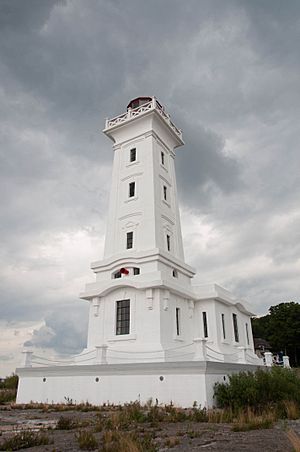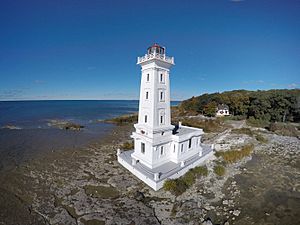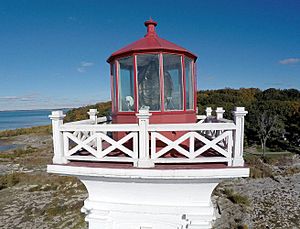Point Abino Light Tower facts for kids
 |
|
|
|
|
| Location | Fort Erie Ontario Canada |
|---|---|
| Coordinates | 42°50′9.96″N 79°05′42.72″W / 42.8361000°N 79.0952000°W |
| Year first constructed | 1917 |
| Year first lit | 1918 |
| Automated | 1988 |
| Deactivated | 1995 |
| Construction | Poured concrete |
| Markings / pattern | White with red accents |
| Height | 30 metres (98 ft) |
| Focal height | 27 metres (89 ft) |
| Original lens | Third-order Fresnel lens |
| Range | 15 nautical miles (28 km; 17 mi) |
| Characteristic | Fl (3) W 12s. |
| ARLHS number | CAN-385 |
The Point Abino Light Tower is a famous lighthouse located on the rocky northern shore of Lake Erie. You can find it at the southern tip of the Point Abino peninsula, just west of Crystal Beach, Ontario, Canada. This lighthouse has a classic Greek Revival style. It features a white square tower with bright red details. The tower is connected to a building that used to house a fog alarm. The home for the lighthouse keeper is also nearby on the shore.
People thought about building a lighthouse here as early as 1855. However, the dangerous shallow area (called a shoal) was only marked by buoys for many years. In 1912, a special ship called the Buffalo Lightship was placed there. Sadly, this lightship sank during the terrible Great Lakes Storm of 1913. Because of this, and because more ships were using Lake Erie, the Canadian government decided to build the tower in 1917.
Why Was the Lighthouse Built?
People realized Point Abino needed a lighthouse a long time ago. In 1855, an inspector from the United States said a lighthouse with a foghorn here would save many lives and a lot of property. This was especially true because most ships on Lake Erie traveled along the northern Canadian shore.
Before 1912, the shallow areas around Point Abino were only marked by floating buoys. Then, the Buffalo Lightship was placed there in 1912. This was a ship designed to act as a lighthouse. But a huge storm, the Great Lakes Storm of 1913, caused the ship to sink in November 1913. All its crew members were lost.
The peninsula itself has an interesting past. It was once home to a Jesuit missionary named Claude Aveneau. Later, it became a place for quarries and sawmills. By the late 1800s, wealthy people from New York and Ohio started buying land here. They built large summer houses among the forests.
Because more ships were traveling on Lake Erie, the Canadian government decided to build a proper lighthouse. They hired William P. Anderson to design it. Construction began in 1917. The lighthouse was meant to help guide ships safely through the busy eastern end of Lake Erie.
The wealthy summer homeowners formed a group called the Point Abino Association. They made an agreement with the government. This agreement meant that people could only reach the lighthouse by water. So, the lighthouse was built right on a rocky shelf at the end of the point. The lighthouse keepers had to wade through shallow water to get to it! Even during construction, building materials had to be brought in by boat.
What Does the Lighthouse Look Like?
The Point Abino Light Tower is a white square tower built from poured concrete. It has five levels and gets narrower towards the top, with bright red details. It's connected to a one-story, flat-roofed building that used to hold the fog alarm. A concrete path connects this building to the lighthouse keeper's home, which was built in 1921.
The lighthouse stands about 87 feet (27 m) above the lake. Its light was very strong, about 60,000 cd, which means it could be seen from 15 miles (24 km) away. The top part, where the light shines, is made of iron and painted red.
Inside the top room, there's a special Fresnel lens. This lens helps make the light very bright and focused. It used to be lit by liquefied petroleum gas. The light would flash three times. There was a short pause between the first two flashes, and a longer pause after the third flash.
The lighthouse also had a diaphone fog alarm. This horn was on the south side of the building, about 33 feet (10 m) above the water. It would make three loud, two-second blasts every minute to warn ships in foggy weather.
The lighthouse property has a gate and is located at the end of Abino Road. Its fancy design was chosen to match the beautiful summer homes in the area. This made it unique among lighthouses in Ontario. The lighthouse keeper's house was built in the Arts and Crafts style, fitting in with the natural surroundings.
The keeper's house was made of wood and painted grey, with a red roof. It was about 300 feet (91 m) from the lighthouse itself.
In 1988, the Point Abino Light Tower became the last lighthouse in Ontario to be automated. This means machines took over the job of the lighthouse keeper. It was then officially stopped from being used in 1995.
A National Historic Site
The town of Fort Erie bought the lighthouse property and building in 2003. It includes the deck, the tower, and the old fog alarm building. The Point Abino Light Tower was officially recognized as a National Historic Site of Canada on July 15, 1998. It was added to the Canadian Register of Historic Places in 2009.
In 2011, a big project began to restore the building. It cost $1.4 million to fix it up! Money came from the government and from selling the old lighthouse keeper's house. The rest was paid by the town of Fort Erie. Workers fixed the concrete base, rebuilt the balcony, and put in new windows and doors. The whole building was painted, and the entrance was highlighted with red paint. They also removed old lead paint and added special coatings to protect the building. The lantern structure at the top was carefully restored to look just like it did originally.
On June 8, 2012, a special commemorative plaque was revealed. Important people like Member of Parliament Rob Nicholson and local leaders were there. Members of the Point Abino Lighthouse Preservation Society, a group of volunteers, also attended.
Today, you can visit the lighthouse by walking or cycling during certain hours. You can also take a shuttle bus run by the Point Abino Lighthouse Preservation Society. This group works hard to keep the lighthouse in good shape. Tours are limited to two per month, with a maximum of 25 people per tour. This helps protect the historic site.




